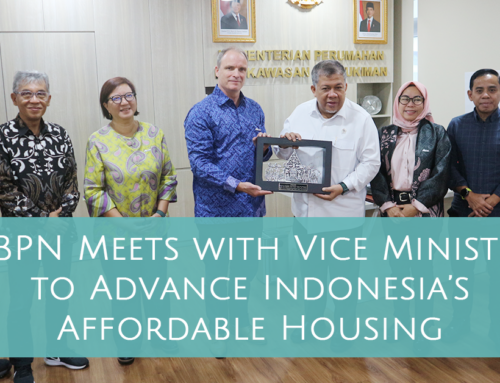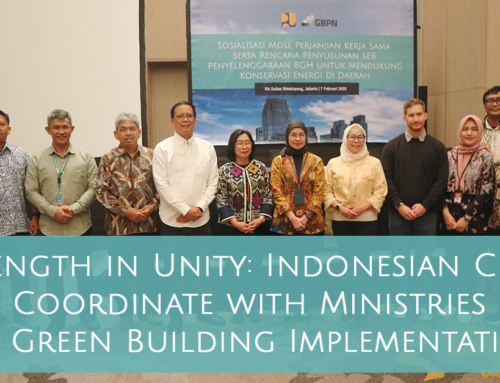A Theory of Change articulates an organisation’s vision for impact into a clear framework that will deliver specific, desired change.
GBPN has published a new Theory of Change as part of its mission to transform the building sector – currently one of the earth’s most significant carbon pollution sources. GBPN Executive Director, Dr. Peter Graham, said articulating the way we work was important not only for GBPN, but also others working towards the same goals.
“As an organisation, we are creating strategies that are evidence-based, proven, scalable and transferable to other locations. Clearly articulating the way we deliver change means we can share our methodologies with others and expand our impact together.
“The time for incremental change is long past. We need to radically change the way we build to have any chance of keeping global warming to 1.5oC or less.”
Dr. Graham described GBPN’s Theory of Change as a blueprint for how to influence positive change from the bottom up.
“We are demystifying the complexity myth – which is that when you look at the buildings sector from the top down, it looks very complicated. But when you speak to experts within the sector and work from the bottom up, it becomes very clear what the steps should be,” he said.
“In the process of developing our Theory of Change, we also are describing our Theory for Change. It’s not just about how we go about things as an organisation, it also tells the story of what we’ve done. Our Theory of Change can be read horizontally, vertically and as a narrative showing how we work to transform practices contributing to climate change in the buildings sector.”
The two-phase Theory of Change project was led by Christina O’Hagan, GBPN Head of Operations. True to GBPN’s ethos, it was a bottom-up and collaborative effort with the entire organisation participating.


GBPN teams bringing the Theory of Change to life through a collaborative work approach.
“We put our heads together to see how we could best represent what we do, how we do it and what is the impact achieved. In our ToC we have tried to answer questions like what will make the greatest impact? What will accelerate the change? How do we work?” Ms O’Hagan said.
“We have simplified the process for ourselves as well as anybody who wants to know what our amazing organisation does.”
Understanding our Theory of Change

Inputs
We have built trust with philanthropists for over a decade and are now sought after for guidance on where to invest for maximum impact. We work in partnership with philanthropy to create a strategy that aggregates impact. We believe in a bottom-up approach, with our people being key drivers of change in their communities. We emphasise the importance of local expertise and a network effect, where ambitious goals are achieved through collaboration with people, organisations, stakeholders and governments. Our network is composed of trusted experts and voices, which has allowed us to take on ambitious projects such as policy reform and market transformation in the pursuit of decarbonisation of the building sector.
Change Levers
We craft policies with a long-term perspective, recognising its crucial role in supporting market transformation. We are particularly dedicated to ensuring a just transition, striving to enhance access to sustainable buildings for everyone, not just the affluent. From a public policy standpoint, we place significant emphasis on the drivers of health and resilience. We are creating new knowledge by trying to do things in novel ways, and also exploring new innovative methods to facilitate change.
Intermediate outcomes
Intermediate outcomes are crucial in our pursuit of zero emissions buildings and combating climate change. Rapid policy adoption, mandating zero emissions for all buildings, is paramount. Equally vital is ensuring inclusive finance for sustainable building projects. We emphasise private sector commitment to drive ambitious sustainability goals, fostering government confidence in setting higher standards. Additionally, our focus on resilient, affordable housing addresses the urgent impact of climate-related extremes. Our commitment to knowledge and innovation, and capacity building for stakeholders accelerates progress.
Breakthrough Outcomes
The breakthrough outcomes are the effects of our process of change. Governments at all levels adopt ambitious zero-emissions policies for buildings, with collaboration between the public and private sectors to ensure sustainable financing. Developers commit to zero-emissions standards. National building codes prioritise healthy and resilient buildings, aligned with complementary policies, emphasising universal access as a social contract and a commitment to human rights. We focus on achieving efficient coordination and networking among change-makers, with funding supporting these goals, aiming for new buildings to achieve zero emissions by 2030 and all buildings to achieve zero emissions by 2050.
Find out more about our strategy for bottom-up policy reform.
Share This Story, Choose Your Platform!
Stay in touch with how we’re transforming the buildings sector
GBPN runs innovative building policy reform programs in key regions around the world that aim to tackle the climate emergency by decarbonising the buildings sector. Stay up to date with our newsletter.
Stay in touch with how we’re transforming the buildings sector
GBPN runs innovative building policy reform programs in key regions around the world that aim to tackle the climate emergency by decarbonising the buildings sector. Stay up to date with our newsletter.







